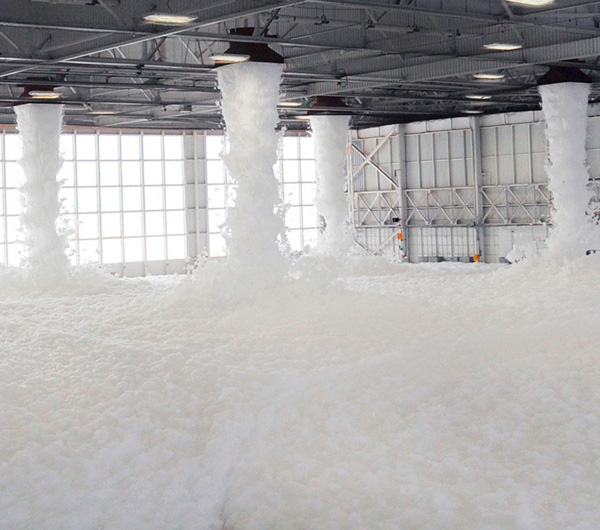
Description and Applications
The systems of quenching foam Low, Medium and High Expansion operate with the logic of the plants to flood with the difference that they deliver the foaming mixture through special devices foaming acts to produce a blanket of foam compact and extended to cover the surface of any area in flames. The plants are constituted by a control system, realized by means of a valve deluge, a device of automatic control, based on fire detectors or even manual type, and a mixing system, which would create the mixture of water – liquid foaming necessary .
The main applications are in the process industry with the use of flammable products such as the protection of watersheds, parks containment tanks. The foam system in fact can be used to cover the surface of the basin in a few minutes and realize both the action of extinction, is a remarkable action of inerting in the event of a spillage of flammable liquids to fire risks.
In the mixing devices “mixing ” is the preparation of the foam mixture, the mixture preparation usually takes place in three ways:
- for aspiration of the foam with injectors
- injection of foaming pump
- for moving liquid, membrane tanks.
Mixing suction
The mixing is done by suction with ejectors denominated “mixers line ” energy using water under pressure to suck a metered quantity of foam concentrate and mix it with water. The amount of foaming in the mixture is determined by the diameter of the orifice calibrated inserted in the tube alleging the foam ejector. The mixers line aspire forming liquid from a tank through a dip tube. A check valve prevents water from entering into the foaming in the case of back pressure in the downstream line.
These devices, which work at the expense of the energy possessed by the water under pressure, give rise to a loss of load important and therefore must be used keeping always constant and equal to the nominal flow rate with that of the lance used. The rated capacity of the mixer line varies from 200 to 2000 liters per minute of water mixture – foam with a supply pressure of between 7 and 8 bar.
Mixing for moving liquid
The mixers displacement of liquid are a particular variant of the suction systems. These devices consist of a pressure tank inside which is located a bladder (or membrane) of rubberized fabric that contains the foam and from a pre-mixer, located outside. The membrane that prevents the foam stored inside the tank from coming into contact with the water and with the wall of the vessel, thereby avoiding the dilution and possible contamination of the foam and the tank corrosion. The tanks can be either vertical or horizontal. The pre-mixer itself and a Venturi tube inserted in the pipe which feeds the fire water system. Upstream of the venturi nozzle comes off a pipe, which connects the socket to the part of the water tanks, while downstream of the nozzle, before the diffuser cone, is detached from the stub of a pipe that connects to the drop tube on the top of the tank in the foaming. After the venturi is placed a check valve type automatic or manual, which is open at the time of commissioning of the plant. Similarly the water inlet to the pre-mixer or is always open or is closed by an automatic valve that opens before the control valve.
When the plant is not in service the two liquids (water and foam) are at the same pressure, while when the plant is in operation the liquid foaming agent is to be at lower pressure. The water therefore enters the tank, press on the bladder wall and moves the foam that comes out from the top and is sucked into the Venturi tube, where the mixing with the water. The percentage quantity of foam-forming liquid is adjusted by a diaphragm with a calibrated hole fitted in the pipe before the mixer.
The mixing for injection occurs by means of pumps that lead forming liquid at a pressure higher than water, enabling it to be placed in the flow of water that feeds the plant.
The dosage for injection may be done with various systems. The most used are:
- Dosage pressure balancing and fixed orifices;
- dosing flow with variable demand.
The dosage pressure balancing and fixed orifices is achieved with a device which keeps the discharge line of the foam at a pressure higher than a predetermined value to that of the water network. This is usually achieved by recycling the excess foam to the tank. Each manifold water that serves a generator or a group of generators, has its own separate line of injection of the foam into which is inserted a calibrated orifice. The release of the foaming water remains constant even so as the pressure of the fire prevention system.
The device Flow Assay variable in question is composed of a venturi and a valve that regulates the pressure of the liquid foaming agent. The valve is controlled by the water pressure upstream of the venturi and the line pressure of the foaming agent. The two pressures act on the two opposite faces of the diaphragm which is fixed the valve stem. The displacement of the diaphragm causes the shutter increases or reduces the free cross section of passage in the valve inputting more or less foaming depending on the vacuum created by the venturi. The foam enters the water next to the venturi nozzle at a pressure equal to that of incoming water.
A variant of the mixers for injection are those with Proportioning Idraulics. They consist of a hydraulic motor and coaxial by a volumetric pump. The hydraulic motor is driven by all the water that feeds the plant, while the volumetric pump withdraws the foaming agent from a tank at atmospheric pressure, located next to the group of mixing, and injects it into the water, immediately downstream of the engine Hydraulic. The big advantage is that these systems do not have needs external power for their operation, the energy being supplied from the same fire water feeding the plant.
The foam generators are:
the ejectors that use the foam mixture under pressure which feeds them to aspirate airs and mix with the same solution forming bubbles that form the foam. In this case one obtains foams with expansion ratios low to medium – high; devices which, by blowing air into a jet of atomized foam solution, to cause turbulence bubble formation to which is given the shape and size required by passing them through the meshes of a net. In this case we obtain foams with high expansion ratios.
Depending on the chemical – physical characteristics of the foam used, ie the ability to lower the surface tension of the solution of the solution, the foam generators or may not require a “expansion chamber ” which allows the foam to develop fully.
low-expansion foam generators
The generators of low expansion foam are generally used in plants for the protection of tanks of flammable liquids and fuels at atmospheric pressure.
They are called foam lances fixed and are generally of logs flanged pipes are inserted into the foam systems. The entrance is positioned a nozzle from which exits the jet of foam solution of appropriate shape to produce the venturi effect and a good turbulence which favors the creation of the foam. On the wall of the nozzle are also present at the nozzle of the openings for the air inlet.
fixed roof tanks
For the protection of fixed roof tanks are three different systems:
- system from application
- system with application from the bottom through a floating hose inside the tank;
- system from the bottom through the application of the product lines or high lines specially crafted.
The system is the most popular application from. On the outer wall of the tank, below the base of the roof, is applied a “camera – foam “, consisting of a vertical cylindrical vessel in which enters the inlet pipe from the bottom of the foam. This container has an output side connected with a pipe flange to which crosses the shell of the tank and that the other end is connected to a pourer that has the task of conveying the foam on the shell of the tank so that it can descend along it until it reaches the surface of the burning liquid.
Inside the chamber the tube stops ending with a pair of flanges in which is inserted inside a glass disc of predetermined thickness, possibly etched to facilitate breakage by the action of foam coming from the lance. At the top of the chamber – foam is positioned a tight cover for periodic inspection and possible replacement of the glass. The function of the glass is to ensure the seal between the inner tank and the piping of schiuma.Una launches can also supply more than a pourer.
During the dispensing of foam the standard NFPA recommended spraying with water of the exterior of the shell to prevent the foam, in contact with the sheet superheated, is dried before reaching the liquid.
The system with application from the bottom with floating hose is possible with the nozzle located in a vertical container located inside the tank or in a container oblique located outside the vessel. The tape is ejected from the foam under pressure.
The system with application from the bottom through fixed pipes requires the use of special foam lances and foams which do not become contaminated during passage through the product.
The injection can reduce the path from the bottom of the foam on the liquid fire and is therefore a viable alternative to placing top tanks with a diameter of less than 30 meters. The quantity of input points of foam on the bottom are a function of the diameter of the tank and the flash point of the product.
The floating roof tanks have along the entire perimeter of the roof system a continuous seal to prevent the evaporation of the liquid contained in the tanks. This sealing system comprises of gaskets of material that has a degree of fire resistance. Above the roof, at a certain distance from sealing devices, there rises a bulkhead circular steel plate which serves to receive foam in case of fire in correspondence of the gaskets. When the roof of the vessel is floating there is no more free space between the “pontoon ” and the surface of the liquid and, therefore, there can be power only along the circumference of the roof itself.
In this case the jet coming out from the spouts bumps on a shield of sheet metal and from there descends on the inner wall of the tank reaching the ring and flows in both directions until it joins with the foam of the two generators adjacent.
generators at medium and high expansion foam
The foam generators can be of the suction type or of the type with so-called forced air blower fan guns. The generators medium expansion are all of the suction type, while those with high expansion can be either of the suction type to both air insufflation. For generators, high expansion, the fans can be driven by turbines driven by the same solution that feeds the generator or by electric motors. What generators high expansion of the suction type, the induction of air is produced by the action of a battery of nozzles.
The types of plants are two feasible:
- high expansion foam systems with full saturation
- high expansion foam systems for local application.
For the total saturation are used mainly generators forced ventilation, while for the local application using generators self-priming.
High expansion foam systems with full saturation
The total flooding systems (total flooding system) are used to fill basements, cellars, bunkers, sheds large craft stores. In the protection of large warehouses, to reduce the volumes to be filled can be used expedients such as, for example, the controlled descent of curtains of incombustible material (woven glass wool and the like) fixed at intervals on the ceilings. The presence of permanent or temporary walls allows the high expansion foam build up and then roll back to the area on fire. Appropriate vents must be provided to prevent the combustion products are recycled in the air that feeds the generators. The design of these systems is very challenging.
The commissioning of the plant is essential because you can get an effective control and extinguishing the fire. Therefore an automatic fire detection and alarm is necessary to actuate the system foam. Optical and acoustic warning should be installed to alert personnel present.
In the design of high-expansion foam systems with full saturation should be taken into account the following factors:
- Minimum height of the foam blanket
- Volume required to submerge the material to be protected;
- Time required to submerge the material to be protected;
- flow foam request.
For high expansion foams minimum height must not be less than 110% of the material at risk and in no case shall be less than 60 cm above this height.
The volume of submersion for high expansion foams is determined by multiplying the area of the floor of the space to be protected for the minimum height required for the foam, may be deducted from the result, the volumes of containers, machinery or other equipment that are located permanently in such space.
The immersion time for the high-expansion foams depends on the type of material to be protected. These times are between 2 and 8 minutes. Less time may be needed in the case of materials with a flash point less than 38 °.
The extent of foam required for high expansion foam can be determined with a formula specified in the standard NFPA 11. The amount of foam available shall be sufficient for at least 25 minutes of continuous operation, or four times the time of submersion.
By maintaining the volume of submergence must be ensured for 60 minutes.
For foam systems for local application (local application system) are preferably used generators medium – high expansion. The systems are used for indoor and outdoor use and are adopted particularly in the protection of shelters load of cars and iron – tanks of flammable products, the pump rooms of refineries, in containment tanks flammable liquids, settling tanks for mineral oils, etc.. The detection systems automatic fire are generally of the type with fusible plugs or ampoules for their simplicity.
The flow rates required for solid and liquid fuels must be such as to ensure complete coverage within 2 minutes of the protected area with a foam layer at least 60 cm high. The entire system must operate for at least 12 minutes.
fixed Monitors
The guns monitors foam fixed and the divalent water – foam are very specific uses. Find jobs in the oil jetties, on the decks of tankers on elevated heliports and industrial installations. The arrangement of the guns monitors must take into account the reduction in stroke volume resulting from adverse wind conditions.
The monitors can be powered directly from a pipe of foam mixture produced with one of the methods previously described, or be individually equipped with a mixer in which they arrive water and foam under pressure.
The monitors can be controlled manually with hand lever or gear, or remotely by means of hydraulic, pneumatic or electric. The foam rods of the monitors can be equipped with baffles (remote controlled) to switch from full jet to jet nozzle.
The monitors can achieve load capacities from 20,000 to 40,000 liters / minute.


